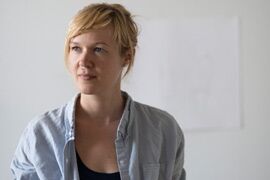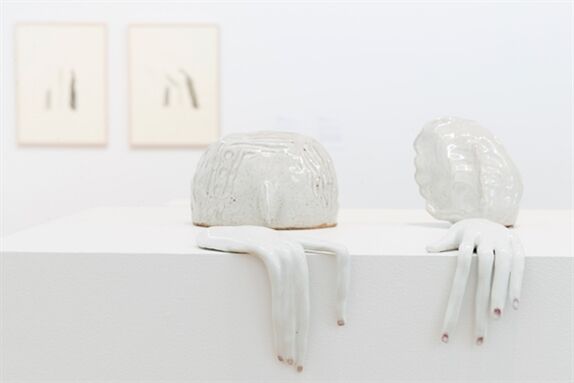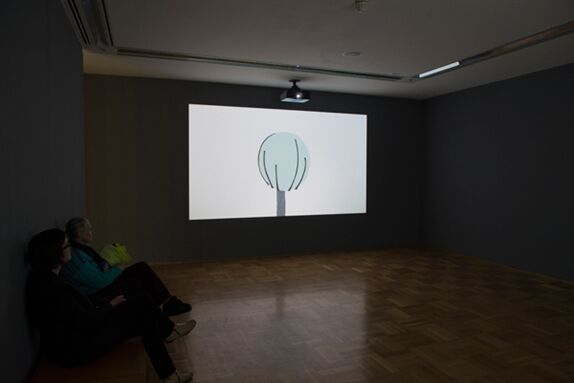
2D or Not 2D

by Anjulie Rao (MA 2014)
Lilli Carré (BFA 2006) has been getting a fair amount of attention lately—from her 2013 full-page profile on the cover of the Arts & Life section of the Chicago Tribune, to her recent accolades as an illustrator, short film maker, and storyteller. Carré has rapidly become a major figure in both the Chicago art and comics scenes; in her first solo exhibition at Museum of Contemporary Art, Chicago, she has moved from working purely in two dimensions to working in ceramics—incorporating two, three, and four dimensions. The final product is not entirely different: her three-dimensional ceramic objects possess similar qualities of line and form, and are heavily infused with movement.
In what ways are you working with perspective with your recent sculptural work? Flatness is a typical characteristic of comics—can you tell me how perspective influences your work in the strict-comics sense?
I am not concerned with perspective in a more accurate, illustrative sense, or looking to draw the world as is appears. I am more focused on a graphic arrangement and with how to write with the language of comics as a mixture of images and text, as well as how much visual information and expression to use within each panel in order to best communicate the story. In my own comics, I can follow the trajectory of my style over the years and see that it’s getting flatter and more pared down. I’m drawn to images of the human figure and comics that really embrace looking flat and graphic while having some idiosyncrasies and awkwardness to them. I'm interested in how simple but expressive I can make the characters and their world, while including just enough information to have the appropriate mood for the story and a sense of place. As I craft a page I am taking into account the rhythm of how a reader might progress from panel to panel. I’m thinking about how the complexity of the drawings and visual information within a comic panel in combination with the amount of text will invite the reader to linger on a certain part, or pull them along faster through the moment of the story.

Why the move to ceramics?
Trying out working in ceramics this year for the first time has been a different world, working with a medium that is not flat and that is so new and unusual to my hands and way of working. It is really the first time I have invested in making work that is very physical as both a process and an object, and is not meant for the book, wall, or screen. What I enjoy about clay is how difficult it is for me to work with, and how failure really comes with the territory? so many of the things I make come out cracked or entirely different than I had aimed for. It changes course along the way, either in my own hands as I build it, or in the glaze chemistry, or when fired in the kiln. The lack of control there is something that I seek out constantly in my practice, having a constraint to push against.
Is the medium essential for a viewer to experience your work?
I’m interested in many formats and platforms of showing work, but the ones I am the most fond of are of the more populist variety that communicate to a broad audience, specifically comics/books, cinema, games, and the Internet. I like thinking about how an image, sequence, or story can be experienced in different ways—in this case, an image moving in time as an infinite loop, or as sequential pages in a book controlled by the reader as a small, manipulable object. As someone who works in different media, I’m always thinking about what would be the best place to encounter and present a certain idea.

Since you have relationships with both the art and comics communities in Chicago, can you speculate on why there has been a turn toward exhibiting comics in an art setting?
I think people outside of that world are recently realizing the potential of comics as a form, and that there is a whole vibrant history there that has been largely disconnected from the fine art world, even though there is shared common ground.
One thing I really respect about people who make comics is the extreme amount of devotion that it takes, and how humble and divorced it is from any larger scale ambitions of fame or money. People who make comics seem to do it almost entirely out of a love of the form, a need for expression, and a way to tell stories and thoughts through a language that combines visual elements and the written word. The work ethic (and usually solitude) required to make comics and animation lines up with the humble attitude and strong work ethic sometimes associated with Chicago in general. Also, Chicago has an interesting history with the influence of comics and figurative/character-based work in the work of the Imagists. That, paired with the city perhaps realizing that they are surrounded by a very strong comics community that has been making interesting and unusual work, has maybe led to people being more open-minded about exhibiting and shining more light on contemporary comics and comic history.
To view more images of Carré's work—as well as her interests and travels—visit her site, Kettle O' Fish.
